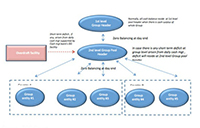Changing the Game in Asian Transaction Banking: Part 1
John Laurens, Head of Global Transaction Services at DBS

The strong emergence of Asian countries on the world stage is creating new competitive dynamics, technology innovation and trade patterns, such as the growth of south – south trade routes. This is impacting business models, growth strategies, trading practices and cash management amongst all businesses operating in Asia and beyond.
At the same time, the level and speed of change in financial market infrastructure in many Asian countries, from new clearing system to currency, tax and trade regulations, is creating complexity but also opportunity for treasurers and finance managers doing business in Asia. For example, the journey towards RMB internationalisation is continuing apace despite the current market correction, and developments such as two-way cross-border sweeping are increasingly driving discussions with corporates.
Click here for SWIFT global payments innovation (gpi).
Addressing treasury objectives
At DBS, we are constantly exploring how big data can be employed and are using an artificial intelligence to develop a platform to predict potential trade fraud for customers. The enhanced levels of risk management this will deliver to clients will be significant.
Working capital management is another space which uses big data. We have developed a number of tools, including real time analysis, projections of future cash flows and cash conversion cycle diagnostics. This advisory work has elevated our engagement with customers. Today, DBS acts as a key strategic business partner to customers helping them achieve their commercial objectives.
Consequently, working capital discussions with customers have become more focused. No longer does working capital management involve simply reporting on working capital metrics e.g., days payable outstanding (DPO), days sales outstanding (DSO) and days inventory outstanding (DIO). Instead, customers are increasingly taking advantage of DBS’ industry benchmarking services to understand their relative performance across a range of cash and trade-related activities. In addition, our in-depth diagnostics enable customers to identify inefficiencies and opportunities for enhancing performance against key working capital metrics. This is the result of considerable investment in sophisticated technology, rich data and expertise: for example, we have invested in training over 2,000 of our customer facing executives trained in working capital advisory to support customers and inform our solution offerings.
Diversification and optimisation
As treasurers’ scope of influence becomes wider and they need to respond to changing competitive, market and regulatory conditions, their banking strategy is also changing. Historically, many companies’ goal was to rationalise their banking relationship to a single global banking partner for transaction banking, but this has changed significantly over recent years. In particular, the need to diversify risk has been far better understood since the global financial crisis. This does not simply mean dividing transaction banking business across one or two additional global banks. Instead, treasurers are seeking to shape their banking relationships to balance their risks more precisely, and ensure access to best-in-class solutions, services and depth of network across the company’s geographic footprint. For example, managing bank risk today involves minimising the impact of decisions made by banks to rationalise sprawling global networks by exiting particular countries. This has become a far more apparent trend recently, and it is prompting many companies to appoint regional banks that are more deeply entrenched in the markets they operate. For example, a company operating globally with one or more transaction banks for each of their core regions, and sub-regions (such as North Asia, ASEAN, Australasia etc.) will often select banks that are headquartered and/or have established core markets in these regions. Not only are these banks likely to continue investing in their home and/ or core markets, but they will typically have deep engagement in local markets with effective relationships with regulators and key market participants, as well as integration into financial infrastructures.
(This article was first published in Treasury Management International: Changing the Game in Asian Transaction Banking.)
Subscribe to DBS BusinessClass
Stay updated with the latest market trends and industry insights, connect with a network of entrepreneurs, and gain access to exclusive event invitations. Join Asia's fastest growing business community – get your complimentary membership here.




